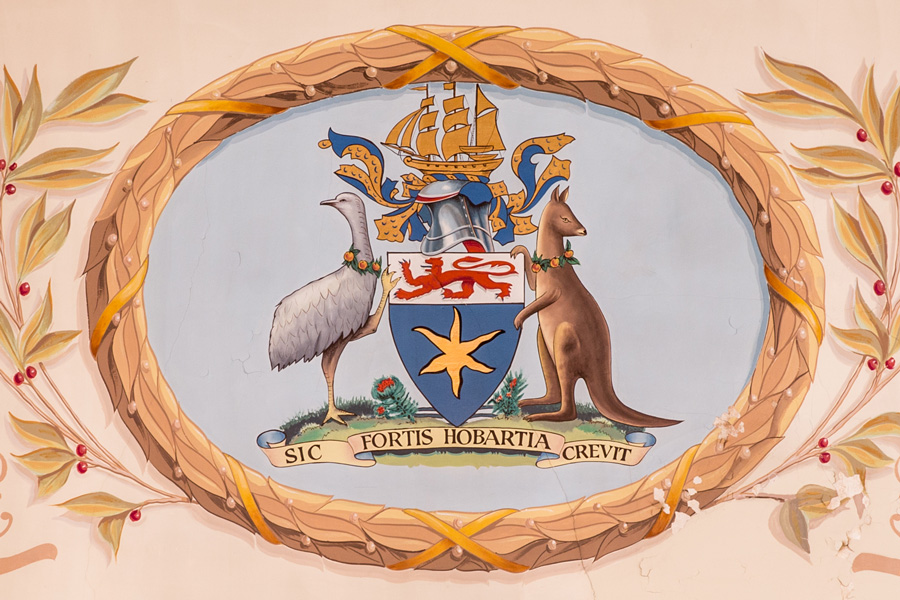Hobart Coat of Arms

The Coat of Arms was formally granted to the Lord Mayor, Aldermen and Citizens of the City of Hobart on 1 May 1953. A copy of the Letters Patent granting the Coat of Arms is displayed in the vestibule of the Town Hall. The original document is held by the Archives Office of Tasmania.
The Coat of Arms was designed in 1951 by Hobart architect and Alderman IG Anderson. It replaced an earlier unofficial crest used by the Corporation since the 1850s. The motto Sic fortis Hobartia crevit – thus in strength did Hobart grow – is featured on both the Coat of Arms and the earlier crest.
The Coat of Arms is used by the Lord Mayor and Aldermen for correspondence related to civic and ceremonial matters. Section 336 of the Local Government Act 1993 provides the option for a council to adopt arms in the form of a badge, crest or flag, or a combination of these. A council may display and use the arms in any manner it thinks fit. The Section also prescribes that a person must not use or display the arms of a council without its approval. A penalty applies if anyone does so.
Elements and meaning
Each element of the Coat of Arms has particular meaning, as outlined below.
Shield
'Blazon' or official description: Azure on Estoile Or on a Chief Argent a Lion passant Gules.
Translation: The lower part of the shield has a gold six-pointed star (with wavy rays) on a blue background. The upper part of the shield has a red lion walking to the right (of the bearer) on a white or silvery background.
Significance: The star is derived from the arms of Lord Hobart, 4th Earl of Buckinghamshire (1760 - 1816), Secretary of State for War and the colonies at the time of colonial settlement (1804), and after whom Hobart is named. The colour used on the arms of Lord Hobart was, in fact, sable (black), rather than blue. The red lion is from the Tasmanian flag - and its location at the top of the shield signifies Hobart's position as the Capital City.
Crest
'Blazon' or official description: On a Wreath Argent and Azure A three masted sailing Ship (representing the Flying Childers) in full sail Or, Mantled Azure doubled Or.
Translation: Above the helmet is a white (or silver) and blue wreath, upon which is set a gold three-masted ship (the Flying Childers). The helmet has ribbons of blue and gold.
Significance: The helmet is associated with civic heraldry and is often used for municipal authorities. The ship was a whaling ship, built in Battery Point in 1846, and signifies the importance of shipping and whaling to Hobart's industrial and economic development.
Supporters
'Blazon' or official description: On the dexter side, an Emu and on the sinister side a Kangaroo both reguardant and each gorged with a chaplet of Apples leaved all proper.
Translation: On the shield bearer's right side is an emu, and on the left side, a kangaroo, both with their heads looking back, and each with a collar, comprising a small garland of apples leaves - all represented in natural colours.
Significance: The Tasmanian emu (now extinct) and the Forester kangaroo (endemic to Tasmania) are references to the unofficial crest used from the 1850's, and provide a connection with the Australian Coat of Arms (granted in 1912). The animals have collars to deliberately distinguish them from the national coat of arms; the apples signify the importance of the apple industry to the state - known commonly as the 'Apple Isle'.
Base
Significance: The base of the shield is a green island, alluding to Tasmania, and the blue wavy lines represent the surrounding seas. Growing upon the island are two examples of native flora, the Richea (or flowering grass tree), which grows on the slopes of kunanyi / Mount Wellington and the Tasmanian waratah.
Motto
'Blazon' or official description: Sic Fortis Hobartia Crevit
Translation: Thus in strength did Hobart grow
Significance: The motto was part of the old Common Seal and was retained when the new Coat of Arms was introduced. It was first used by the Rev. Robert Knopwood, in his diary at the end of 1804, literally translated by Knopwood as, 'Thus by industry Hobart Town increased'. The motto is derived from another commonly used motto Sic fortis Erutria crevit - used in Book Two of Virgil's 'Georgics' - Etruria was an important area of central Italy inhabited and governed by the Etruscans. This motto Sic fortis Erutria crevit was used in relation to the Colony of New South Wales from 1790.
